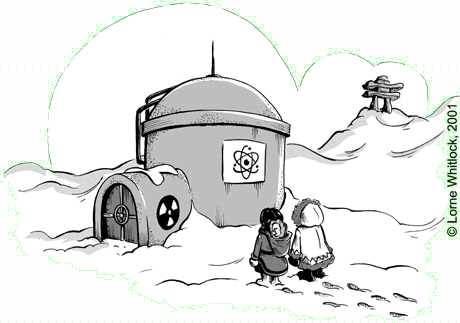Published in the March 2001
issue of the Canadian
Nuclear Society Bulletin, Vol.22, No.1. Artwork
courtesy of Lorne
Whitlock.
NANUKE OF THE NORTH by Jeremy Whitlock
There are strange things done in the midnight sun, - Robert Service, from "The Cremation of Sam McGee" With all the hand-wringing over pollution and energy use, it's easy to forget that many communities in our own backyard burn diesel oil like, well, their lives depend on it. In the Canadian Arctic (translation for Torontonians: way north of Algonquin Park) diesel is King. In many regions it is burned for transportation, heating, and electricity – total dominance of the energy market. While pampered southern minds reel at the thought of running diesel generators for anything but back-up power, locomotive-sized engines on the tundra operate year-round, 24 hours a day, seven days a week. The new territory of Nunavut consumes 33 million litres of diesel fuel a year for the production of electricity. Over one quarter of that (9 million litres) is used to run the capital of Iqaluit, located at the head of Frobisher Bay, Baffin Island. But electricity, as every adult Canadian knows, is just the start. The 5,000 inhabitants of Iqaluit consume a further 20 million litres of diesel fuel each year for space heating, primarily by circulating water from household boilers (in some cases by forced-air furnaces). Plans are on the horizon, however, to heat some larger buildings with cooling water from the town's three massive diesel generators. Clearly, one supposes, the creative minds entertaining these thoughts of cogeneration and centralization will turn, sooner or later, to the question of a better fuel source. If ever there was a perfect application for nuclear energy, it is remote district heating (okay, perhaps second to military submarines). No other technology is as good at making hot water, particularly in remote regions. Its flexibility, zero emissions, and low fuel supply make it the cleanest, safest, and most efficient way to make a pot of tea, bar none. Arctic dwellers, of course, have little time for the cleanest, safest, and most efficient way to keep themselves warm. At heavily subsidized diesel prices, few incentives exist to switch to other fuels, including uranium. And who knows – with predictions of Arctic ice melting due to global warming, the denizens of Iqaluit may even cast secret smiles upon the 100,000 (completely avoidable) tonnes of CO2 they belch into the atmosphere each year. But one must avoid jumping to conclusions. Atomic Energy of Canada Ltd. (AECL) was once active in the district-heating market, and perhaps the time is right to breathe new life into this program. Let's make Iqaluit, one of Canada's fastest growing communities and newest territorial capital, a model of environmentally sustainable frontier growth for the new millennium (spin doctors take note). After all, the ground work is already there – it's a little-known fact that Iqaluit was once earmarked by the Diefenbaker government for a massive nuclear heating project. In the late Fifties a design existed for an enclosed dome around much of the community, heated by a nuclear reactor buried in a nearby hill. Sadly, the Treasury Board, not known for its nuclear vision, canned this project in favour of the more modest development in evidence there today. We would have been forty years ahead of China, which recently announced innovative plans to heat its northeast city of Shenyang with two low-temperature 200MW reactors developed at Qinghua University. Let us dust off AECL's Slowpoke Energy System, an in-ground pool reactor designed to supply 10,000 kW of hot water for space heating. This technology could be plugged into the existing heating system of most buildings in Iqaluit. The reactor's inherently safe, low-temperature operation could be monitored by local engineers, much the same as diesel plants are today. A central nuclear engineering office could provide high-level technical support for several northern communities simultaneously. Best of all, the plant would produce no emissions, and its tiny fuel load would be flown in once every three years. The summer shipment of diesel oil to Frobisher Bay would be a shadow of its former self. AECL shopped its SES technology around Canada during the Eighties, and came close to installing one at the University of Saskatchewan, before deciding that the competition with fossil fuels wasn't worth the fight. With nuclear power you can't just be comparable in cost, you must be persuasively superior. (Surely the spiralling price of natural gas would sweeten the argument today?) Another problem in remote regions is that electricity must still be generated, and it makes sense to use one fuel type. To this end, let's finish our development of the Nuclear Battery. These brilliant devices, explored by AECL in the Eighties, can be hooked to a Rankine-cycle engine to crank out 600 kW of electricity (about 200 homes' worth), or they can supply high-pressure steam. They are small, passively safe, and run for 15 years before needing replacement. The coolant for the Nuclear Battery is based on heat-pipe technology that uses no moving parts (hence the "battery" spin). The fuel is based on TRISO coated uranium-dioxide particles – the same inherently safe concept at the heart of South Africa's new Pebble-Bed Modular Reactor (PBMR), seen by many as the future of the industry. A bank of AECL-designed Nuclear Batteries would supply the heating and electrical needs of Iqaluit, at a cost comparable with diesel fuel. If residents wish to go further and wean themselves off diesel transportation fuel, we can add a few more Batteries to electrolyze hydrogen from Frobisher Bay, and Ballard Power Systems would happily convert their vehicles. As a consumer of transportation, heating, and electrical generation fuel, Iqaluit would be virtually independent of the rest of Canada (and an icon of environmental sustainability for the world). That kind of True North Strong and Free may be getting a bit ahead of ourselves, but it doesn't hurt to dream.

| ||||
|
Discussion welcome.
©2011 Jeremy Whitlock
| ||||
|
|
